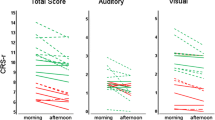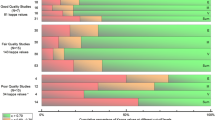Summary
In this work a new coma scale for the assessment of responsiveness in acute brain disorders, constructed near the year 1985 by Scandinavian investigators, the Reaction Level Scale (RLS85), is compared with two other coma scales namely:
-
(i)
the Glasgow Coma Scale: (GCS);
-
(ii)
the Edinburgh-2 Coma Scale, after modification: (E2CS(M)).
The study proceeded in the form of a statistical analysis of assessments made on 46 patients according toRLS85 and GCS (i.e., when comparison was with GCS) and on 28 patients according toRLS85 and E 2CS(M).
In all 74 cases two physicians participating as “observers” carried out the assessments. They were both contacting the patient-not together but- successively within a time interval of less than 20′. Hence the data appeared as “pairwise” observations for any of the three scales above.
The results of the analysis, arising from a rather strict statistical reasoning, can be summarized as follows:
-
(1)
The rank correlation coefficient rs between: (i)RLS85 and GCS sum score, (ii)RLS85 and E 2CS(M), was found to be at a satisfactory level meaning that all three scales indicate almost the same “ranking order of severity”.
-
(2)
Reliability was compared by taking into account as to what extent the two observers agreed on RLS 85 and-simultaneously—disagreed on the other scale. The “sign” test was applied and as a result RLS85 proved to be more reliable than: (i) GCS (EMY profile), (ii) GCS sum score, and (iii) E2CS(M), in all the above mentioned at a high level of significance.
-
(3)
Apart from the test above, some values of the index k (kappa) of interobserver agreement were calculated. Those corresponding to RLS 85 are considerably higher. In particular the overall value based on 74 pairwise assessments amounted to k=0.733 associated with a standard error σk=0.061. This was a satisfactory result regarding the features of RLS 85.
-
(4)
As far as coverage is concerned, again—by the “sign” test—the predominance of RLS 85 versus GCS (EMY profile) was accepted.
Similar content being viewed by others
References
Barolat-Romana G, Larson SJ (1984) Influence of stimulus location and limb position on motor responses in the comatose patient. J Neurosurg 61: 725–728
Born JD, Albert A, Hans P, Bonnal J (1985) Relative prognostic value of the best motor response and brain stem reflexes in patients with severe head injury. Neurosurgery 16: 595–601
Braakman R (1985) Assessment of severity of head injury. Scandinavian Symposium on Neurotraumatology, May 20–23, Göteborg Sweden
Braakman R, Avezaat CJJ, Maas AIR, Roel M, Schouten HJA (1977) Inter observer agreement in the assessment of the motor response of the Glasgow Coma Scale. Clin Neurol Neurosurg 80: 100–106
Braakman R, Habbema JDF, Gelpke GJ (1986) Prognosis and prediction of outcome in comatose head injured patients.In: Lindgren S (ed) Modern concepts in neurotraumatology. Acta Neurochir (Wien) [Suppl] 36: 112–117
Brihaye J, Frowein RA, Lindgren S, Loew F, Stroobandt G (1978) Report on the Meeting of the W.F.N.S. Neuro-Traumatology Committee, Brussels, 19–23 September 1976. Acta Neurochir (Wien) 40: 181–186
Cohen JA (1960) A coefficient of agreement for nominal scales. Educ Psychol Measurem 20: 37–46
Cohen J (1968) Weighted Kappa: nominal scale agreement with provision for scaled disagreement or partial credit. Psychol Bull 70: 213–220
Edna T-H (1983) Risk factors in traumatic head injury. Acta Neurochir (Wien) 69: 15–21
Fleiss JL (1971) Measuring nominal scale agreement among many raters. Psychol Bull 76: 378–382
Fleiss JL (1981) Statistical methods for rates and proportions, 2nd ed. Wiley, New York, pp 211–236
Fleiss JL, Cohen J (1973) The equivalence of weighted kappa and the intraclass correlation coefficient as measures of reliability. Educ Psychol Measurem 33: 613–619
Galbraith S, Murray WR, Patel AR, Knill-Jones R (1976) The relationship between alcohol and head injury and its effect on the conscious level. Br J Surg 63: 128–130
Guilford JP (1975) Psychometric methods. Data McGraw-Hill edition, Haryana, pp 278–280
Haines SJ (1983) Randomized clinical trials in neurosurgery. Neurosurgery 12: 259–264
Holmgren E, Lindgren S, Starmark JE, Stalhammar D (1985) Assessment of coma and severity of head injuries in Scandinavian countries. Acta Neurochir (Wien) 78: 73–74
Jennett B, Teasdale G (1977) Aspects of coma after severe head injury. Lancet i: 878–881
Jennett B, Teasdale G, Braakman R, Minderhoud J, Heiden J, Kurze T (1979b) Prognosis of patients with severe head injury. Neurosurgery 4: 288–289
Jennett B, Teasdale G, Galbraith S (1979a Assessing brain damage. J Neurosurg 50: 271
Langfitt TW (1978) Measuring the outcome from head injuries. J Neurosurg 48: 673–678
Langfitt TW, Gennarelli TA, Obrist WD, Bruce DA, Zimmerman RA (1982) Prospect for the future in the diagnosis and management of head injury. Clin Neurosurg 29: 353–376
Lindgren S (1986) Time-related severity scaling of head injuries-Discussion on the AIS-severity code-early and late. Acta Neurochir (Wien) [Suppl] 36: 23–24
Maas AIR, Braakman R, Schouten HJA, Minderhoud JM, Van Zomeren AH (1983) Agreement between physicians on assessment of outcome following severe head injury. J Neurosurg 58: 321–325
Nordby HK, Nesbakken R (1984) The effect of high dose barbiturate decompression after severe head injury. A controlled clinical trial. Acta Neurochir (Wien) 72: 157–166
Plum F, Posner JB (1986) The diagnosis of stupor and coma. 3rd ed, seventh printing. FA Davies Company, Philadelphia, pp 4–5 and 329–348
Ponten U (1986) Guidelines for care in the acute phase in hospitals without neurosurgical specialists: Introduction.In: Lindgren S (ed) Modern concepts in neurotraumatology. Acta Neurochir (Wien) [Suppl] 36: 58
Price DJ (1986) Factors restricting the use of coma scales. In: Lindgren S (ed) Modern concepts in neurotraumatology. Acta Neurochir (Wien) [Suppl] 36: 106–111
Spitzer RL, Williams JB (1985) Classification of mental disorders. In: Kaplan HI, Sadock B (eds) Comprehensive text-book of psychiatry/IV, vol I, 4th ed. Williams and Wilkins, Baltimore, pp 591–598
Stalhammar D, Starmark JE (1986) Assessment of responsiveness in head injury patients. In: Lindgren S (ed) Modern concepts of neurotraumatology. Acta Neurochir (Wien) [Suppl] 36: 91–94
Stalhammar D, Starmark JE, Holmgren Eet al (1988) Assessment of responsiveness hi acute cerebral disorders. A multicentre study on the Reaction Level Scale (RLS 85). Acta Neurochir (Wien) 90: 73–80
Starmark JE (1985) Analysing “coma scales”. The introduction of a new scale. The Reaction Level Scale (RLS 85). Thesis — Göteborg
Starmark J, Lindgren S (1986) Possible mechanisms of vegetative state. Acta Neurochir (Wien) [Suppl] 36: 121–122
Starmark J, Stalhammar D, Holmgren E (1988) The Reaction Level Scale (RLS85).Manual and guidelines. Acta Neurochir (Wien) 91: 12–20
Surgiura K, Muraoka K, Chishiki T, Baba M (1983) The Edinburgh-2 Coma Scale: A new scale for assessing impaired consciousness. Neurosurgery 12: 411–415
Teasdale G (1975) Acute impairment of conscious level-1: Assessing “conscious level”. Nursing Times 71: 914–917
Teasdale G, Jennett B (1974) Assessment of coma and impaired consciousness.A practical scale. Lancet ii: 81–84
Teasdale G, Knill-Jones RP, Van Der Sande J (1978) Observer variability in assessing impaired consciousness and coma. J Neurol Neurosurg Psychiatry 41: 603–610
Tesseris J, Routsi Chr, Mandragos K, Semenelakis S, Behrakis P (1989) The neurosurgical patients in general intensive care unit (submitted for publication)
Van Den Berge JH, Schouten HJA, Boomstra S, Van Drunen Littel S, Braakman R (1979) Interobserver agreement in assessment of ocular signs in coma. J Neurol Neurosurg Psychiatry 42: 1163–1168
Author information
Authors and Affiliations
Rights and permissions
About this article
Cite this article
Tesseris, J., Pantazidis, N., Routsi, C. et al. A comparative study of the Reaction Level Scale (RLS 85) with Glasgow Coma Scale (GCS) and Edinburgh-2 Coma Scale (modified) (E2CS(M)). Acta neurochir 110, 65–76 (1991). https://doi.org/10.1007/BF01402050
Issue Date:
DOI: https://doi.org/10.1007/BF01402050




